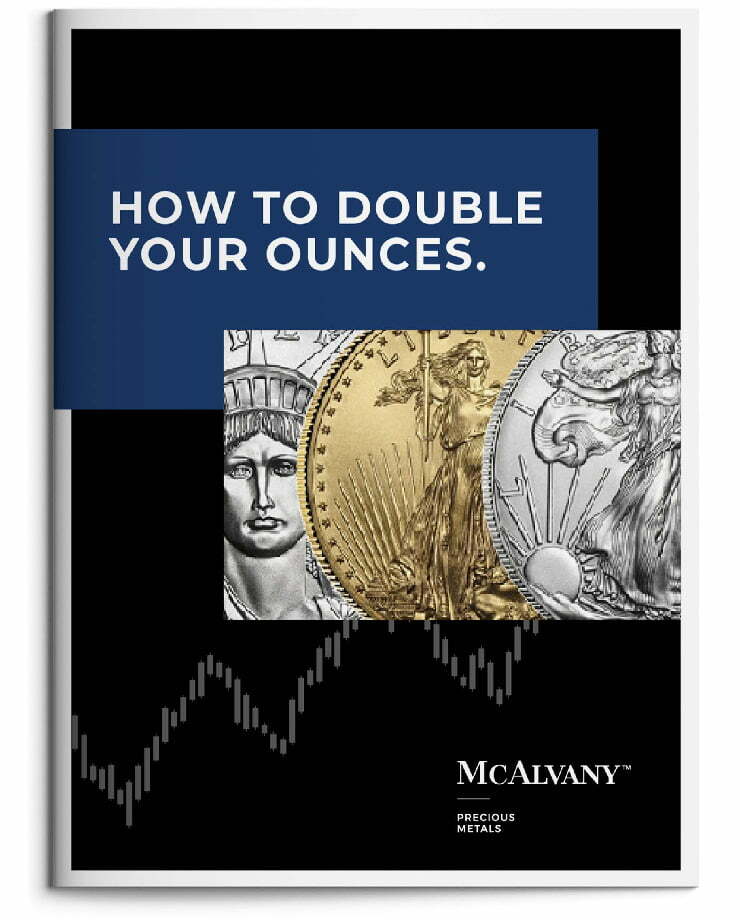Podcast: Play in new window
- Gold & Silver’s Gains Correcting Down This Week
- Long Term Monetary Regime Change Points To Much Higher Gold
- The Case for a New Price Reality – Latest Hard Asset Insights
“The nature of gold being the anti-fragile asset for every investor because we’re all dealing with the same things. By the way, we topped 650,000 yen per ounce this week after starting the year at closer to 400,000 yen. I think the yen price of gold serves as a reminder of what gold is telling you in any currency, that gold is real money and fiat is just another form of credit.” —David McAlvany
* * *
Kevin: Welcome to the McAlvany Weekly Commentary. I’m Kevin Orrick, along with David McAlvany.
David, finally, it’s strange to be in a precious metals business and be happy when it’s down, but we’re finally getting what we hadn’t been seeing for months, and that is a correction in these markets.
David: You go two or three weeks and every day is $20, $30, $50, $120.
Kevin: Up.
David: Up. You just think, “This is relentless. Where does it end?”
Kevin: Right.
David: And then it does end, and it’s either the very end of a bull market or it’s in an interim phase. Yeah, I think we are in fact, in the interim phase. Third, fourth inning, but thank you, it’s about time. 10%, 15% lower for gold and silver. That’s in the category of a gift. That’s how I would see it. We’re most of the way there already. It moves fast. And by the way, counter-trend moves tend to do that. They’re grinding one direction and they’re sharp and short the other direction.
Kevin: And that’s what you’re expecting at this point. After listening to Morgan Lewis talking both at the MWM meeting and even this morning, we realize that we’re seeing a major regime change in the monetary system. So I would imagine your central banks, which have been pushing this market up, are probably going to be buyers after this correction again.
David: And I think metals are in the early stages of being normalized as an asset class amongst global investors as well, so that it is taking a pause does allow for investors to step in. And again, the normalizing of the asset class is pretty important. It’s something that’s pretty new to most investors. September ETF flows show that investors are beginning to take an interest, but yes, it is time for a correction.
Kevin: Well, and the other thing that you’ve been watching is the outperformance of silver relative to gold. That ratio, we started to see silver outperform, and you started realizing that was going to change the market a little bit.
David: Well, and we suggested this at the beginning of the year that you would see confirmation of a bull trend and an entrance into an acceleration phase when mining stocks outperform the physical metals, when there was an increase in ETF flows, and when outperformance of silver relative to gold occurred. We’ve had all three, which is supportive to the long-term bull case, though, again, I would be more enthusiastic if the gold-silver ratio could break out of the 80s. It did so for a nanosecond last week, but has since returned to 85 to one this week. By the middle of next year, I think it will be in the mid-60s on the ratio.
Kevin: Well, and just for the record, for those who are watching this, you actually started the recording late this morning because you moved some of your gold over to silver when the ratio hit that number.
David: No, that’s right, but I’m also grateful that I’ve got a vault plan in the Vaulted program, and the time that it took for one trade to settle, all I had to do is refresh the page, settled, and then I went back in and purchased the silver. Refreshed, settled, there I have my new ounces in silver. So no, this morning, as a matter of fact, was the deposit. Yesterday was the deposit into my Vaulted account and the trade settled this morning at lower numbers, which I was grateful for.
Kevin: Right. And then you moved over to silver after that, right?
David: That’s right.
Kevin: Yeah. Well, it’s probably important, too, as we go through these corrections to go back and review the bigger picture. And Morgan Lewis’s Hard Asset Insights on our website is something that our listeners can read every Saturday morning after he posts them on Friday.
David: Yeah. I would encourage— This weekend’s missive is a must-read for perspective on how we see the unfolding bull market in metals. In fact, “encourage” might be too soft. I insist you take the time to read Morgan Lewis’s Hard Asset Insights this weekend. Nothing short of a structural monetary regime change unlike anything we’ve seen since 1944 and the creation of Bretton Woods. It has positive implications for the precious metals for years to come. Not so positive if you’re looking at our currency, but Morgan shares the highlights from our investor conference in this week’s HAI. You won’t want to miss it.
Kevin: Dave, of course, Hard Asset Insights can be found on our website at McAlvany.com, but we should just include that on our show notes this week.
David: Yeah, we’ll put it down below for sure.
Kevin: Okay, so let’s say we get a 5% correction, say today or tomorrow. What are you looking for? What would be typical on a correction after seeing what we’ve seen with gold, if it can be stated?
David: Yeah. Well, first of all, I think your core position, you sit tight, you add on a correction for latecomers to this bull. It’s just helpful to know that a 10%, 15% correction is in line with historical upside pressure alleviation. Things run and run and run, and it does pause, and so this is a super healthy thing. Morgan ties together the policy inclinations of the current administration, which are explicitly dollar negative, driven by a combination of industrial policies, debt alleviation via inflation.
So again, in the broader context, a very strong support for the metals, a 15%, a 10% correction. Likely, I think that’s at the front edge of a broader market decline—I’m thinking of the S&P and the NASDAQ, for instance. This is where you look at risk assets, and risk has been ignored. It won’t be ignored forever. And there are times in the last 20 years where gold was at the front edge of a broader decline, and then all of a sudden people rethink risk and clamor back to own gold shortly thereafter while you have the remainder of decline in your equities.
Kevin: Well, and I think that’s important to remember. In 2008 when gold did decline, I mean it lost about a third of its value just almost overnight. Now, the physical metals, you couldn’t get them at that number, but it was actually a front-runner for a broad market decline. In the S&P 500— I’ve got a question for you, you just came back from a conference, and you were speaking to a group of people who are relatively informed investors. Was there an awareness of the gold market at this time?
David: I had assumed, given the degree of education and the involvement in their direct asset management, that they would’ve understood the gold market very well. So I spoke to a group of 400 to 500 investors. This was last week. And so I dived right into portfolio composition and precious metals trading strategies and the best way to navigate the bull market.
Kevin: You were assuming that they knew what you were talking about.
David: I was assuming that they understood why gold and silver. The why, that was obvious. I mean, we’re well into a bull market if this is third or fourth inning. This is not the fresh, first pitch of the game. What don’t you know? Of course, you understand this.
Kevin: One of the top performing assets in all of the asset structure. Yeah.
David: Arguably the top performing asset. You’ve got miners up 130% and a range from 60% for gold, over 70% for silver, 80% to 83% in the platinum group metals. Obviously, prior to the correction, but this is what I was sharing with them last week, and there was this dumbfounded look on their face. So 53 years has taught us a few things. I was trying to distill for them more of the why us than why gold, because there is a healthy way to navigate these markets and to be able to compound ounces takes the proper portfolio composition on the front edge.
Kevin: And a little historic knowledge.
David: Yeah. So metals hit an all time high last week, retested those highs yesterday for a nice double top. And across the crowd, there were only a few that knew anything about it.
Kevin: Isn’t that typical? The thing that’s amazing is gold is in the news now, yet people are still giving you blank stares.
David: Yeah. So where the metal is trading, blank stares. What are the returns year to date? Blank stares. Interest in crypto? Off the charts. Interest in real estate and a host of other highly illiquid assets, very interested in that. Set the tone for every conversation. It was absolutely fascinating. Only one conversation at this conference stood out, a corporate credit analyst in the audience concerned about market liquidity flipping fast in the months ahead, very aware of the metals market. And he’s also a routine reader of the Credit Bubble Bulletin.
Kevin: Well, there you go. No wonder.
David: Risk awareness was otherwise very low, and it makes sense that gold was not on their radar. Because they’re not thinking about risk, they’re not thinking about wealth insurance. And plain and simple, that’s what metals are is wealth insurance. You tell me if the awareness of risk is priced into the financial markets today.
Kevin: Well, and I think it’s interesting, too, their interest in crypto, because crypto is an interesting market that if a person’s not making money in it, there’s not a lot of reasons to own it. And gold on the other hand, we can be happy about a correction because we have thousands of years of experience of something that actually maintains value and goes up over the long haul.
David: Accumulating real wealth, having the opportunity to do it at a cheaper price, you’re accumulating real wealth. You asked me a question last night and I was fascinated by it, and it’s a question you’ve asked many people with an interest in crypto. If the price is not going up, are you still interested?
Kevin: Are you still interested in owning it? Yeah. The question is, if you knew the price wasn’t going to go up, is this something you would still want to own?
David: There is a difference between a repository of wealth—what we have in gold—and this future revolutionary product, which will change everything. That’s the view of cryptocurrencies, is this is the new goal. This is the new way forward. This is the new monetary system. I had one lady say, “Don’t you know there’s a new treasury?” And I said, “Do you mean corporate treasuries, because they are buying a lot of crypto?” She said, “No, no, no. There’s a new treasury department.” I’m like, “What are you talking about?” But it is the new everything.
Kevin: Well, on YouTube, it’s the new everything. If you get all your information from YouTube, then it definitely is. But Dave, you’ve been reading the IMF’s report and they did actually address stablecoin as one of the things that they’re looking at right now as a factor going forward.
David: Yeah. So engaging with this audience, a better informed group of individual investors focused on self-managing their retirement assets, I would estimate that less than 10% in the crowd has any exposure to metals whatsoever. So as I explained, the metals are overbought, but they are structurally under-owned. This group represented a larger and largely unallocated populace. So my advice, pay attention to price declines and be opportunistic.
Kevin: Well, and Bill King said it best. He said, “Wait till the army ants arrive.” And the army ants are the people who haven’t bought it yet.
David: So to your question on the IMF, they issued their bi-annual global financial stability report this week.
Kevin: It’s only 120 pages, and I know that you love reading 120-page reports written by large banks.
David: Well, midnight came last night, and I decided it’s not going to get completely read, but some of the highlights, there are stretched asset valuations, one of the key observations in the paper. Secondly, there are mounting fiscal strains. These are all things that—
Kevin: We know.
David: Right. But for them, this is the structure of the financial markets, and we need to be aware of the risks in light of these things. So they’re stating facts, facts that we’re well familiar with, but they’re concerned about what happens next.
Kevin: And it’s global. IMF is always global when they’re looking, right?
David: Correct. So stretched asset valuations, mounting fiscal strains, increasing bank, non-bank financial intermediary interconnectedness.
Kevin: So control of the banking system, they’re losing control of the banking system.
David: Well, I’d say it differently. I would say that there’s a strange relationship between commercial banks and shadow banks. And that risk is underappreciated, this interconnectedness, because when you look at the commercial bank balance sheets, things look pretty clean. There’s not a lot of risk. There may be tranches of risk that they retain.
Kevin: But they’re dealing with something that’s unregulated.
David: That’s right. And so it’s a form of capital arbitrage, and it’s something that the IMF is very keen to understand and have factored into a risk assessment. And then the last thing, you mentioned it earlier, a rising prominence of stablecoins in the financial markets. And so the summary: the IMF worry meter is high. We’ll look at each one of these factors just briefly, but I’m still working through the 120-odd pages. So far, I’d say it’s spot on.
Kevin: Well, okay, so you brought up that the financial markets, one of the things that they said is the financial markets are stretched, right? And so the ratios that we’ve looked at in the past, like the Buffett ratio, cyclically adjusted price earnings ratio, the Shiller, all of those are topping out at virtually all-time highs.
David: And one of the reasons they talk about valuations being stretched, and almost as: this is normal, it’s normal in the context of ample liquidity. So they start with a simple but critical observation that financial conditions have eased considerably since April, and that is propelling asset prices higher. Credit spreads have come lower, but they note, and this is a quote from the paper, “the ground is shifting beneath this seemingly tranquil surface.” So again, today we have over-liquefied markets, which feeds into over-valuations. We’ve highlighted the Buffett ratio north of 215%. We’ve talked about the Shiller PE, sometimes referred to as the CAPE.
Kevin: 40% plus, right?
David: 40.2. Worth pondering as you as an individual investor assess risk versus rewards as you’re looking at a 60-40 portfolio allocation. Also, worth projecting forward: future probable returns from these levels.
Kevin: Well, wouldn’t you say that’s why 60-40 is now being changed by Wall Street to 60-20-20? I think that’s it.
David: Sure. Yeah, I think there’s a realization, and it actually factors into two of the other things that they’re considering. Not only the bank/non-bank financial intermediary interconnectedness and the impact that that has into the credit markets, but they also see stablecoins as having a negative impact on the Treasury going forward.
Kevin: Because they can’t control it.
David: Right. So rates are higher in the Treasury market and they’re higher everywhere. And so the 40% allocated to bonds really in the cross hairs going forward. So valuations are stretched according to the IMF, which is what we’ve been saying. And concentration risks are at record levels. They talk about that quite a bit. We’ve highlighted that previously with the popularity of tech and AI. You could illustrate it this week by the 10 AI names combined to a trillion dollar valuation, not a single one of the top 10 AI names have profits. So a trillion dollar valuation with zero profits.
Kevin: That’s not being talked about. What we’re hearing is, what direction are the stocks going to go?
David: What’s revolutionary is we’ve been here before, and we’ve learned nothing. Yes, the innovations are profound. Yes, the world will be different. And yes, the first -edge investor is the one who gets their butt handed to them. It’s usually the second phase investor who does very well because you get to pick up the pieces. You get to see, of those 10 companies in AI, two or three will survive. So the belief is, invest in all of them, and you’ll be fine on average. Well, what about, you let the mania run its course, crash, and then like a Cisco or an Intel or an Amazon, own them at 10 or 15 cents on the dollar? The ones that have survived. Okay, so it’s not a question of I’m not interested in AI. It’s a question of I’m not interested in paying nosebleed valuations for companies who have no profits, most of whom will fail in the next market contraction.
Kevin: Well, and you have to put aside bragging rights for a little bit. The fear of missing out, a lot of times it’s the fear of not being able to talk to your friends about what you’re buying that they’re buying. But if you can experience relief—so instead of FOMO, ROMO, the relief of missing out. Just watch other people do that. And then, what you’re talking about, second phase, go in and buy when it’s a bargain.
David: Well, we’ve also referenced the four and a half trillion dollar market cap of NVIDIA along with the other high-flying tech names. The top eight, along with NVIDIA, of course, make up a 22.5 trillion combined market cap.
Kevin: That’s incredible.
David: See, the AI name is not making profit. That’s okay. That works in a very liquid market. You just have to recognize that it doesn’t work. And that one fact, no profits, is a force multiplier for declines in the event of liquidity evaporating. So as long as liquidity is abundant, you can play this game, but it is a dangerous game when liquidity leaves the room.
Kevin: So another point that the IMF report talked about was fiscal risk. When you’re talking about liquidity, governments are the ones who print the money, and inflation is created by governments, so fiscal issues as far as overspending. I mean, we’re right now in the middle of a government shutdown. Why? Because we’ve been overspending. We can’t afford what we’re buying.
David: We can’t agree to where the cuts will come from, which is what has created chaos in a number of polities around the world. We’re not alone in this. This was Giulio Gallarotti’s key point when he was on our Commentary maybe in 2010. The budget has been politicized. This was not an issue prior to universal suffrage. Now that you have universal suffrage, you have politicians that have to pay attention to their constituents.
Kevin: So who’s going to vote for them?
David: It’s their survival strategy.
Kevin: Exactly.
David: Their survival strategy politically. If you’re talking about wanting job security, you have to know what the expectations of your constituents are. If you don’t, you’re doomed.
Kevin: You know what it reminds me of, Dave? I’m going to take a little diversion here because over the last couple of weeks with the silver issue, you’ve got a lot of YouTube channels that are just over-sensationalizing what was occurring in the silver market. And it’s really for clickbait. YouTube rewards you for how many views you get, how many likes you get, and so the need to actually put out good news, I mean actual analysis, sometimes is trumped for a lot of these guys by the need to just get somebody to view. And it reminds me of voters. You see where I’m going with this?
David: Yeah.
Kevin: Dave, I really appreciate about you that you try not to sensationalize, you try to analyze, and that is an autonomy that we try to have. It doesn’t matter how many viewers we have if it’s good analysis. So when you’re talking about universal suffrage, a politician at this point, it’s almost like they have to do things for clickbait. Right? I mean, honestly.
David: Yeah. I don’t think this phrase is axiomatic, but the more you’re feeling, the less you’re thinking. And if you want to make good decisions when it comes to your finances, you should probably account for how you’re feeling at a given moment. Whether it is fear or greed, those factors change the calculus.
Kevin: So stop, take a breath.
David: Stop, take a breath, and figure out fact from fiction. Figure out what has been sensationalized, figure out the stake and the sizzle and the difference between them.
Kevin: And if a YouTube that you’re watching gets you all fired up—
David: Hot and bothered.
Kevin: Yeah, stop. Take a breath.
David: Just realize you’re being played. And that’s what politicians do too. They need your energy.
Kevin: For sure.
David: From a sales perspective, create the energy to close the sale. From a political perspective, create the energy to hit the opponent. We’re not interested in truth. We’re interested in friction, because friction is where we win—or we hope to win.
So again, back to the IMF paper, elevated fiscal risks, primarily in advanced economies. They’re very keen on pointing out that actually your emerging markets have done a lot better job financing debt in their own currencies. That’s not always the case. But in this particular market cycle, they’re financing debt in their own currencies, which leaves them less fiscally pressured. It doesn’t mean that they’re managing their ins and outs effectively, but it means they’re not increasing risk by having to pay on a higher-valued foreign currency.
Kevin: Well, and doesn’t it also eliminate the foreign currency—yeah, exactly what you’re saying. It eliminates that risk that we’ve talked about where you have to hedge against the falling, say, dollar.
David: So in this paper, they’re focusing on advanced economies, and the expectation by the IMF is that term premia rise, which is a fancy way of saying that bond yields at the long end are expected to go higher. So the IMF is not alone in this projection. There’s a critical implication to this which has already been expressed. We’ve talked about Mike Wilson, Jeffrey Gundlach, the reduction in allocations to bonds. Those bond positions—and I’m going to speak for them and perhaps they can correct me—those bond positions are now a compromised hedge within a portfolio.
Kevin: It’s no longer resilient, right? That was the word they used. Yep.
David: Yep. Bonds no longer bring adequate balance, and are no longer the same kind of volatility dampener to a portfolio that they used to be in that 60-40 mix. And they both are describing gold as the anti-fragile asset. I guess that’s Michael Hartnett describing gold as the anti-fragile asset. And bonds are to a degree being displaced from the current allocation models. There is a heightened risk to what most investors view as the less, or least, volatile asset class in their 60-40 mix, which is fixed income.
Kevin: So that’s where you get that 60-20-20 or whatever they’re saying.
David: So Wilson, 20% allocation to gold, extraordinary coming from the chief investment officer of Morgan Stanley. Gundlach, 25% allocation to gold. Extraordinary coming from a guy who makes his money trading bonds. Even Jamie Dimon conceded that this is, in his view, a rare time, a rare moment in time where gold is a valid allocation as it trades to between $5,000 and $10,000 an ounce, he says.
Kevin: Yeah, well, thanks Jamie, but I remember gold being 300 bucks, and now I remember gold being over 4,000. So when he says it’s rare that I would actually buy gold, it’s like, “Well, great. Good for you, Jamie.”
David: Yeah. So the pet rock is creating a bit of an embarrassment for you. So say something kind so you’re not completely discredited on your views of gold. It is actually fascinating, too, to see the number of folks who, for years, have taken a hard view against gold. We just don’t own it. It doesn’t make any sense.
Again, go back to Hard Asset Insights over the weekend. If you want the long-form explanation of the structural shifts, not only in the US economy, but the global economy, global system of trade, this is what underpins the move in gold going forward. There’s been other factors that have brought us to this point. And now, the reconsideration of the World Monetary System and the recalibration of the dollar’s role in that system going forward.
Kevin: The petrodollar moving to the petroyuan to a degree, right?
David: Yeah, exactly. So if you’ve ignored gold to this point and felt you had a legitimate justification to do so, I challenge you to read this week’s Hard Asset Insights and see if you don’t come away with a different perspective.
Kevin: So speaking of that, when I think of Jamie Dimon, I also think about some of the bank relationships. And so the IMF, what they were talking about, the iceberg, of course, is used as an analogy. The banks on the top is the top part of the iceberg, but the shadow banking, that interconnectedness to shadow banking. Before we had the 2008 crisis, there were people who were screaming, “Hey, there are a lot of risks right now that you cannot see.” I think that’s what we’re seeing with shadow banking, right?
David: Just interesting, even last week, how differentiated we had the banks in performance and in results. Your big banks gave their Q3 results, and they were all blowout. I mean, just fabulous. Most money they’ve ever made. Ever. And a part of it’s trading, a part of it is increases in deposits. They’ve made money everywhere you can make money. That’s the big banks. The regional banks hit the wall last week, hemorrhaging in the regional banks, in part because he had a couple who discovered fraud in some of the loans that they made. The banks were not committing fraud, but they were subject to fraudulent activity.
Kevin: Fraudulent behavior inside.
David: And so now they have to reserve a lot more than was expected. So I mean, we had some banks down 12%, 15% at their worst last week.
Kevin: They were regional.
David: Regional banks, but then the shadow banks. So you’ve got the differentiation between the big banks— And frankly, the IMF report was pointing to how strong the big banks are. They’re doing very well. Their balance sheets are strong, their liquidity is high, their leverage is low, but the significant chink in their armor is the interconnectedness to non-bank financial intermediaries.
Kevin: Which is a shadow bank.
David: Yeah, the NBFIs, the non-bank financial intermediaries, easier understood as shadow banks.
Kevin: There you go. Another abbreviation that we have to learn, right?
David: Yeah. NBFIs. You won’t forget that.
Kevin: Of course not.
David: A part of the IMF’s critique here is that they’re looking down the road. No issues today, but you’ve got tons of inbound volume into these alternative asset purveyors. So the asset classes are performing well, but liquidity remains very limited on the other side. If it wants to go the other way, it really can’t. So you’ve got private equity, you’ve got private credit, you’ve got hedge funds, you’ve got different specific financial products, collateralized loan obligations, leveraged loans.
That starts the list of leveraged risk assets that are, I guess you could describe it as being remotely financed by the big commercial banks. They’re not directly or entirely held on their balance sheets. So in question by the IMF is how do we get our arms around the daisy chain of exposures because there’s something going on. There’s a long discussion of these assets increasing risk in pension funds, in insurance companies—
Kevin: Well see, that’s what I was thinking. I was thinking, remember AIG just caught everybody off guard back in 2008, and it had to do with similar types of vulnerabilities.
David: Yeah. And I mean we’ve highlighted the insurance company exposure, and we’ve talked quite a bit about private equity firms going on a spending spree for insurance companies, to own the insurance companies, to gain access to as much as $8 trillion in insurance company assets so they can dump the deals they’ve been unable to take to market in another form.
Kevin: Make them bag holders.
David: Yeah, it’s long-term capital. So you’re, again, 8 trillion that’s sitting there to be invested. Nobody’s going to dig for bodies for a long time. I mean this is the perfect field to bury bodies.
Kevin: Here you go, here buy this.
David: Yeah. The back 40 in Nevada, that’s the insurance company dumping ground. One of the concerning aspects of the shadow banks, the NBFIs, is the lack of visibility—said differently, outright opacity—of their balance sheets.
Kevin: Right, they can’t see it.
David: And to give it sort of the stamp of approval, this has a ring to the 2005, ‘6, and ‘7 period where credit rating agencies would say, “Yep, looks good to me,” and move it on down the road. Well, in this case, they’re not publicly available ratings. They basically say, “Trust me, we got this. We looked at the numbers and we give it our signature. You’re good.”
Kevin: Yeah.
David: Not publicly available, it’s outside of the realm of scrutiny. How do you think that’s going to play out?
Kevin: And yet these are assets that cannot be liquidated in normal markets—
David: That’s right.
Kevin: —at the price that they’re claiming they are.
David: That’s right.
Kevin: Yeah.
David: But they can be carried on the book at whatever you want them to be.
Kevin: Right.
David: You’ve got a time bomb ticking in the world of pensions and insurance companies because of this mashup. And again, the IMF report is saying, “Look, commercial banks do own a sleeve of this. There’s some exposure. They’ve offloaded most. And it’s been repackaged into structured financial products that can then be placed in these portfolios.” There was a Financial Times contributor this week who described this as a form of capital arbitrage, credit risk being moved from bank balance sheets where you’ve got heavy regulation to unregulated shadow banks. Banks keep a small slice of exposure, pass the rest on. That was the best article I came across this week. Satyajit Das, the title of the article: “So Much of Credit Securitization Still Relies on Magical Thinking.”
Kevin: Yeah.
David: It dovetails perfectly with the IMF report.
Kevin: Okay, so for the person who’s listening to this who says, “All right, well how does this affect me?” I want to go back to just simple bank ratings, Dave, for at least the 38 years that I’ve done this here with your family’s company, we offer free bank ratings for the person who is saying, “All right, is there a risk?” Now obviously the bank rating doesn’t see everything, but a lot of times it sees the things that you don’t necessarily know on a daily basis.
David: Percentage of non-performing loans, a hot money ratio, which is basically this sort of unloyal, “I’m there for the interest payment, so if you’re paying me 50 basis points more, I’m here today, gone tomorrow,” which just gives you an indication of how secure the deposit base is.
Kevin: It’s just wise to do. You just now said that the regional banks hit the wall even though the bigger banks didn’t, so—
David: And the regional banks are not discussed in the IMF report. It’s a global review of asset prices and global financial markets. But that is where, within the regional banks, that is where some of the bodies lie. 44% loan exposure to commercial real estate amongst your regional banks. If you’re looking at sort of portfolio composition, 44% is pretty high to what is a dying asset class. A dying asset class. Your regional banks are far more exposed. Your majors have 13% exposure. I agree with you. Call our office for a bank rating. Last week, sell-off in regional banks tied to fraudulent loans and increased non-performing assets. These are developments worth watching. Again, this is not a part of the IMF paper, but actually the Financial Times article ties the larger banks into the web of securitization and risk. Please get that article and read it.
Kevin: Well, it’s all interconnected. So let’s go to the last item that you talked about, because we talked about cryptocurrency, but stablecoins, that’s an issue right now with the IMF because while the old system of monetary control, how do you control that when the stablecoins are independently trading?
David: Maybe an interesting twist for people not as familiar with stablecoins, but last on the discussion list in the paper, stablecoins, which they regard it as a risk to monetary policy implementation.
Kevin: Right. Takes the power away from the central bankers.
David: And a further potential destabilizer of the Treasury market. That’s really where they see monetary policy implementation being muted because you’ve got the flows of capital which are going to places they’ve never gone before. They see an altering of the bond market structure from broad stablecoin adoption. And in the event of liquidation, or if there is a liquidation event, an investor run on stablecoins would generate forced selling of the reserve assets behind those stablecoins, which are Treasuries. That introduces upside pressure on interest rates. And what they’re trying to get their arms around is how much of a risk do we have, a trigger lying in wait within the stablecoin market? Is there ever a reason why there would be a mass exodus from stablecoins which would force the unwind of those treasury positions and force rates higher?
Kevin: So Dave, restate one more time why there’s a concern about the stablecoins.
David: Well, a stablecoin has to be backed by an asset, and that asset is a Treasury bill. So in this case you’re talking about, it’s fine as long as the traffic is coming into stablecoins, but if it leaves, if it’s going out of stablecoins…
Kevin: The sale of Treasury bills as well,
David: It forces the sale of Treasury bills.
Kevin: I see. Okay.
David: Forces rates higher. And again, that’s where monetary policy implementation becomes difficult because if you want to change the rate of interest and all of a sudden you’re dealing with this extraordinary influx of supply in the bill and note market, you’re not in control. The Federal Reserve is not in control. And again, the destabilizing aspect within the Treasury market is it can have knock-on effects across the yield curve if you have a spike in rates.
Kevin: Okay. So would you say the IMF report is crying wolf right now? I mean economists a lot of times, especially the IMF, can look at these things and it turns out not to be as much of an issue as they thought.
David: Well, I think anytime you’re trying to understand risk, there’s scenario analysis that’s necessary. And so they’re looking at all the potential areas where there’s vulnerability, and they’re looking for areas that are underappreciated in terms of regulatory risk, where things have been overlooked altogether. And if there’s not an adequate framework for managing the risk, that’s their recommendation: we’re going to have to backfill and change the structure of this market so that we don’t have this risk lying in wait.
So again, crypto and stablecoins as a part of that, it’s like a two-lane highway coming in, but more of a goat trail going out. So liquidity constraints, stablecoins are stable, I would say, in name only. And what the IMF is focusing in on, and this is similar to structured credit products, we were talking about earlier, commercial banks being linked to shadow banks. What they’re looking at is the interlinkages. And so on its own, you don’t think of a stablecoin as being unstable, but you change some variable, you change some traffic pattern, and then all of a sudden you appreciate the interlinkages.
Kevin: It’s like studying the exits when you’re building a theater.
David: Yeah.
Kevin: Yeah. Just making sure that everybody can get out.
David: So the interlinkage between the stablecoin market and the Treasury market— That’s the point, is that we’ve got an untested market dynamic which exists in a liquidation-only market. We’ve had purchases, things have been increasing, 230, $250 billion in stablecoins, and it’s all working well going one way. What is the dynamic in a liquidation-only market? That’s what they’re trying to say. Is this appreciated? Do you see it? Have you wrapped your arms around it? What’s your playbook in the event that—?
So no, I don’t think it’s a cry wolf. This is how you manage risk, is scenario analysis, which means you do waste a lot of time appreciating what the risks are, with only a few of them ever materializing. But when they materialize, and if you’re unprepared for them, it can be catastrophic.
Kevin: Well, and didn’t you say the IMF report talked about a tranquil surface? In other words, what you’re seeing right now is a tranquil surface. Don’t be fooled by what’s beneath.
David: Yeah. Broad summary: economists have a reputation for being dismal. And this report supports that assessment.
Kevin: Yeah.
David: It’s dismal. The ground is shifting beneath this seemingly tranquil surface. Morgan’s insights from the client conference will provide you, I think, some much needed perspective on the structural long-term nature of what is under the tranquil surface.
Kevin: Okay.
David: There are profound and long-lasting relational shifts occurring, again under the tranquil surface.
Kevin: So let’s talk about some changes as we look at Asia this week, because my wife said, “Did you see that there are some key guys no longer playing ball with Xi.” And he’s no longer—
David: Yep. Chinese Central Committee is in its 15th planning session. These are five-year increments. They look ahead and try to say, here’s our road map, here’s our business strategy, if you will. The plenum is in session most of this week, with drafts being ironed out and finalized by March. That’s March of next year. In the next few weeks we’ll have a sneak peek, but Xi’s talking points thus far have had to do with advanced manufacturing, and state security.
Kevin: And we’ve had guests on the show who, their expertise is China, and they’ve said one of the main points that China needs to figure out how to do is to not fund their economy with the government fiscal spending, but maybe shift to consumption, which is a very American thing, but it’s not necessarily a Chinese thing.
David: Yeah. I mean, my two favorite guests on China, Stephen Roach, who’s been on a couple of times with us, and Michael Pettis, who lives in China, was an emerging markets bond trader prior to becoming a finance professor.
Kevin: He’s an interesting guy.
David: Super interesting. Taught at Columbia, now teaches, I don’t remember the name of the university, in Beijing. Also runs a nightclub, ran a music label. He’s just a fascinating guy.
Kevin: He’s an eclectic guy. Yeah.
David: Yeah. He’s hammered that point on rebalancing has to occur for their economy to ever really come right. They’ve had a great growth spurt for 20, 30 years, but there’s been a trade-off, that you’ve seen certain sectors grow tremendously. One of those that has yet to come into maturity is the household sector. And so true rebalancing the economy would shift priorities from investment to consumption. And by investment, I mean state-subsidized, sector-focused government spending.
Kevin: Very, very official, almost socialist type of spending. Yeah,
David: It’s command and control. I hate to say it, but we’re actually seeing some of those aspects here in the United States where we’re saying, we’re going to invest in this company and we’re going to support this area. I get the justification for it, but it does have an echo of command and control dynamics.
Kevin: Not quite free market.
David: No, no, no, not at all. Again, the rebalancing, the need is for a boost to households and not the manufacturing sector. But I suspect that in this next five-year plan, technology and security will continue to be the greatest expression, a strategic focus in a way to control GDP growth at their targeted level. And already we’ve had the National Development and Reform Commission laid out 32 topics for discussion in this plenum meeting. Fourteen focus on investment, eight on consumption. So just even on a relative basis, it’s not going to be as important. And yet that’s what they truly need if they want a long-term sustainable economy. There was three on trade, the rest were a mishmash.
Deflation in China, I think, has the PBOC and the Central Committee inspired to manage things and control what they can control. That means spending their way out. That reinforces the mercantilist sort of export-led growth. And of course, a part of that is credit growth. We’ve seen credit growth at crazy levels in China.
Kevin: Well, and we’ve talked before that you have these variables. Right now you do have a lot of problems in China. Military conflict a lot of times refocuses everyone. So what do you think? I mean, do you think that that’s possibly being discussed also while they’re all together, just not publicized?
David: I always get worried about the possibility of military conflict when unemployment is a big issue. It’s just like the jobs work programs in the 1930s, “Let’s go build stuff. Let’s go dig dirt and make dams and build highways.” I mean, it was absolutely, “We’re going to have a social and political issue if we let people loiter and gripe. Let’s put them to work. It’s absolutely worth spending the money.”
Kevin: Give them a shovel instead of a gun, but sometimes they give them a gun.
David: Give them a gun. As long as the gun’s not focused internal, as long as it’s focused external. So what raises the likelihood of military conflict in the region is the sharp rise in youth unemployment. Who drives revolutions? Who just drove the overthrow of the government in Madagascar? The youth.
Kevin: It’s the youth that don’t have a shovel.
David: And they’ve got a lot of time on their hands. They’re idealistic, they’re bold, they’re brash, and they don’t have fully developed prefrontal cortexes. They’re willing to take crazy risks that no one else will. I mean, by the time you’re 25, you’re thinking, “I don’t think I want to stand in front of that tank. I don’t think I want to…” At 18, what do you have to lose? I mean, you’re Superman, bulletproof. So the youth unemployment, it’s an energy source that, if it’s not harnessed, if it’s not controlled, it becomes a social and political game changer.
Kevin: Okay. So in the United States, economically, I hate to say it, but we consume. That’s sort of our economic growth system, right? Just get everybody to buy something. If you remember, Bush basically said, “Your patriotic duty is to go spend some money.” That’s not necessarily how the Chinese operate. What’s our consumption here relative to China’s?
David: This is where economists would say what they’ve been trying to avoid is getting stuck in the middle income trap, where you’ve got a developing country who is on the ascendancy and you’re getting people out of poverty, but there’s not enough of a middle class yet to sustain the economy on its own. And the middle income trap is where people just can’t quite get to the next rung, and they never really— It devolves again. You’ve got a developing and it becomes an under. It’s the de-evolutionary process for the economist. Household consumption as a percentage of GDP sits at 40% in China. It’s closer to 70%, maybe 68% here in the U.S. And we’ve become the global model. We’ve become the global model because it taps that Keynesian notion of, “Keep every dollar in the system churning as fast as you can.” You’ve got the multiplier effect, particularly with a fractional reserve banking system.
Kevin: Don’t save money, spend it.
David: Spend it. We don’t want the rentier class, we don’t want savings off to the side. Future investment, let government handle that. We have become the aspiration. And consumption as a means of generating as much GDP growth as possible, that is the global model. I’m not saying that that’s ultimately sustainable, but that’s how economists see it.
I would just say that these are insecure times in China. A rebalance is unlikely, and insecurity expresses itself in other ways too, not only the rehash of mercantilist export-led growth models. I mean, they’ve been banging those drums forever. But last Friday, the number two general in the PLA, People’s Liberation Army, purged along with eight other senior commanders. This happened—
Kevin: It’s just consolidating so that these plans go through.
David: Absolutely. It’s both/and. It’s an expression of concern, it’s also a means of communicating to everybody who shows up this week for the plenum meeting, the 15th five-year plan.
Kevin: Better play ball.
David: We’re in agreement, here’s the plan.
Kevin: Right.
David: Does anybody have any objections?
Kevin: Make sure you smile, make sure you clap, and make sure you vote yes.
David: Standing ovation, please. Cue the standing ovation.
Kevin: That’s right. That’s right.
David: So a nice and not-so-subtle reminder of what creates unity in a less than free society, its fear.
Kevin: Fear. Well, before we get away from Asia, let’s talk about Japan because there is a change there and it may definitely be inflationary.
David: Yeah, it’s exciting in many respects. You’ve got a new prime minister, the first female in Japanese history, exciting too if you’re trying to manage savings, because as a protégé of Shinzo Abe, she knows a thing or two about loose fiscal policy.
Kevin: Printing money.
David: And money printing. Yeah. So as soon as the announcement was made, the Nikkei moves higher. The stock market knows that she is future stimulus—
Kevin: The candy man, but she’s the candy woman.
David: Candy woman. Thank you.
Kevin: That’s right.
David: How misogynist.
Kevin: The candy man can, the candy woman can too.
David: Yep.
Kevin: Yeah.
David: So yen weakness, the equity market in the Nikkei, these are the sort of easy anticipated outcomes. A weak yen that actually supports global speculation adds to bubble dynamics in risk assets globally. But this is the crystallization. Growth over fiscal discipline is how the Financial Times describes the next chapter.
Kevin: So what does that mean for the bond market, the yen bond?
David: Well, back to the bond market, back to the IMF saying, “We’ve got the developed world countries and we expect to see an increase in risk premia,” which is to say, an increase in what you pay for the long-term bonds. Can you pursue growth? Can you leave fiscal discipline behind without impairing the Japanese bond market? They already have jaw-dropping debt-to-GDP figures, the highest in the world. So we doubt that this is a positive impact for the Japanese bond market. What you’re likely to see is the gold price in yen move right alongside the Nikkei to higher levels.
Kevin: And wouldn’t you say that that’s in every currency, though? I mean, at this point—
David: Yes, but that gets to sort of the nature of gold being the anti-fragile asset for every investor, because we’re all dealing with the same things, the same kinds of fiscal policies, the same kinds of monetary policy constraints at this point in the game. By the way, we topped 650,000 yen per ounce this week, after starting the year at closer to 400,000 yen. I think the yen price of gold serves as a reminder of what gold is telling you in any currency, that gold is real money. And fiat is just another form of credit.
Federal Reserve notes. Think about it. A Federal Reserve note, that is the dollar. And even with the correction this week in the gold price, it still takes 58% more of those Federal Reserve notes to buy an ounce of gold in US dollar terms, just since January.
Kevin: Well, and it goes back to the question, fiat currency is unlimited. We asked the question, would you still own a cryptocurrency if you knew it wasn’t going to go up? Is there another reason to own it?
David: What’s the point? It’s a risk asset. You own it because you want to profit from it.
Kevin: But gold, there’s a scarcity built into gold that man has never really been able to overcome. There’ve been guys back 500 years ago, the alchemists tried to find a way to make more of it, but they found that it was more costly than actually mining it.
David: They say that scarcity is also the factor that drives cryptocurrencies crazy too.
Kevin: Right. It’s a secret number. It’s very, very scarce.
David: I thought it was less scarce once Paris Hilton was launching her coin next to Doge, Fartcoin, and all the others, which are wildly popular, very valuable, and very limited in nature.
Kevin: Right. That’s true. And the alchemists did not try to make cryptocurrency 500 years ago, so maybe it is a new thing.
David: Again, if you look at the long-term perspective, our industrial and fiscal policies ensure that in the years ahead, it will take more and more and more fiat dollars, yen, or euros to buy an ounce. So I mean, the best trades of 2025 remain selling what is abundant and buying what is scarce. We’ll take more hard assets, please.
* * *
Well, you’ve been listening to the McAlvany Weekly Commentary. I’m Kevin Orrick, along with David McAlvany. You can find us at mcalvany.com and you can call us at (800) 525 9556.
This has been the McAlvany Weekly Commentary. The views expressed should not be considered to be a solicitation or a recommendation for your investment portfolio. You should consult a professional financial advisor to assess your suitability for risk and investment. Join us again next week for a new edition of the McAlvany Weekly Commentary.
















